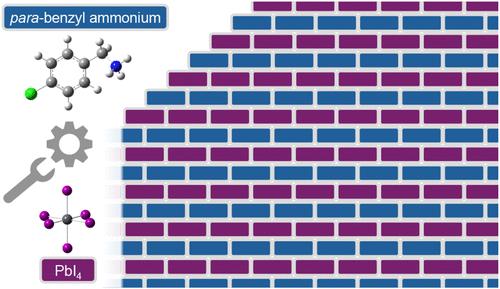苯铵PbI4杂化钙钛矿的光电性能裁剪
IF 7
2区 材料科学
Q2 CHEMISTRY, PHYSICAL
引用次数: 0
摘要
我们提出了一种由苯铵衍生物和PbI4形成的钙钛矿的理论-实验联合研究。采用慢蒸发法合成材料,并结合x射线衍射、x射线光发射光谱和紫外光发射光谱三种实验技术对材料进行表征。研究了电子结构在可见光刺激下的变化。在密度泛函理论的框架下进行了仿真。在结构表征中,我们看到这些层状材料显示出有机和无机交替的平面,化学计量为(XBA)2PbI4,其中XBA是一种苄胺衍生物。考虑到苯胺环对位上的几个官能团(X =−H,−CH3,−OCH3和−CF3),不同钙钛矿的铵盐不同。在费米能级附近,我们观察到pb4f、i3d、c1s和n1s的光电发射光谱发生了位移,这使得我们能够识别不同有机成分钙钛矿电子结构的变化。我们将这种观察到的变化归因于官能团的性质,特别是由苯铵衍生物施加的永久偶极子,因此,我们得出结论,杂化钙钛矿的光电性质可以通过改变有机取代基的吸电子性质来根据需要进行修饰。此外,层状结构、远距离电荷分离(大面间距离)和半导体性质使其成为光激发后有望出现二维电子约束效应的材料,从而在可见光照射下表现出较大的瞬态光电流效应,使其成为光电器件的最佳材料。本文章由计算机程序翻译,如有差异,请以英文原文为准。

Tailoring the Optoelectronic Properties of Benzylammonium PbI4 Hybrid Perovskites
We present a joint theoretical–experimental study of perovskites formed by benzylammonium derivatives and PbI4. The materials were synthesized with a slow evaporation method and subsequently characterized by combining three experimental techniques: X-ray diffraction, X-ray photoemission spectroscopy, and ultraviolet photoemission spectroscopy. Changes in the electronic structure in response to stimulation with visible light were also studied. Simulations were carried out within the framework of density functional theory. In the structural characterization, we have seen that these are layered materials showing alternating organic and inorganic planes with stoichiometry of (XBA)2PbI4, where XBA is a benzylammonium derivative. The ammonium salt varies from one perovskite to another, considering several functional groups in the para position of the benzylamine ring (X = −H, −CH3, −OCH3, and −CF3). We have observed shifts in the Pb 4f, I 3d, C 1s, and N 1s photoemission spectra near the Fermi level, which allow to identify changes in the electronic structure of the perovskites with different organic parts. We attribute such observed changes to the nature of the functional group, in particular, to the permanent dipole exerted by the benzylammonium derivative, and therefore, we conclude that the optoelectronic properties of hybrid perovskites can be modified on demand by altering the electron-withdrawing nature of the organic substituent. Furthermore, the layered structure, separation of charges over long distances (large interplanar distance), and semiconducting properties make it a material in which two-dimensional electron confinement effects are expected to appear after photoexcitation, thus exhibiting a large transient photocurrent effect under visible light illumination and making it an optimal material for optoelectronic devices.
求助全文
通过发布文献求助,成功后即可免费获取论文全文。
去求助
来源期刊

Chemistry of Materials
工程技术-材料科学:综合
CiteScore
14.10
自引率
5.80%
发文量
929
审稿时长
1.5 months
期刊介绍:
The journal Chemistry of Materials focuses on publishing original research at the intersection of materials science and chemistry. The studies published in the journal involve chemistry as a prominent component and explore topics such as the design, synthesis, characterization, processing, understanding, and application of functional or potentially functional materials. The journal covers various areas of interest, including inorganic and organic solid-state chemistry, nanomaterials, biomaterials, thin films and polymers, and composite/hybrid materials. The journal particularly seeks papers that highlight the creation or development of innovative materials with novel optical, electrical, magnetic, catalytic, or mechanical properties. It is essential that manuscripts on these topics have a primary focus on the chemistry of materials and represent a significant advancement compared to prior research. Before external reviews are sought, submitted manuscripts undergo a review process by a minimum of two editors to ensure their appropriateness for the journal and the presence of sufficient evidence of a significant advance that will be of broad interest to the materials chemistry community.
 求助内容:
求助内容: 应助结果提醒方式:
应助结果提醒方式:


